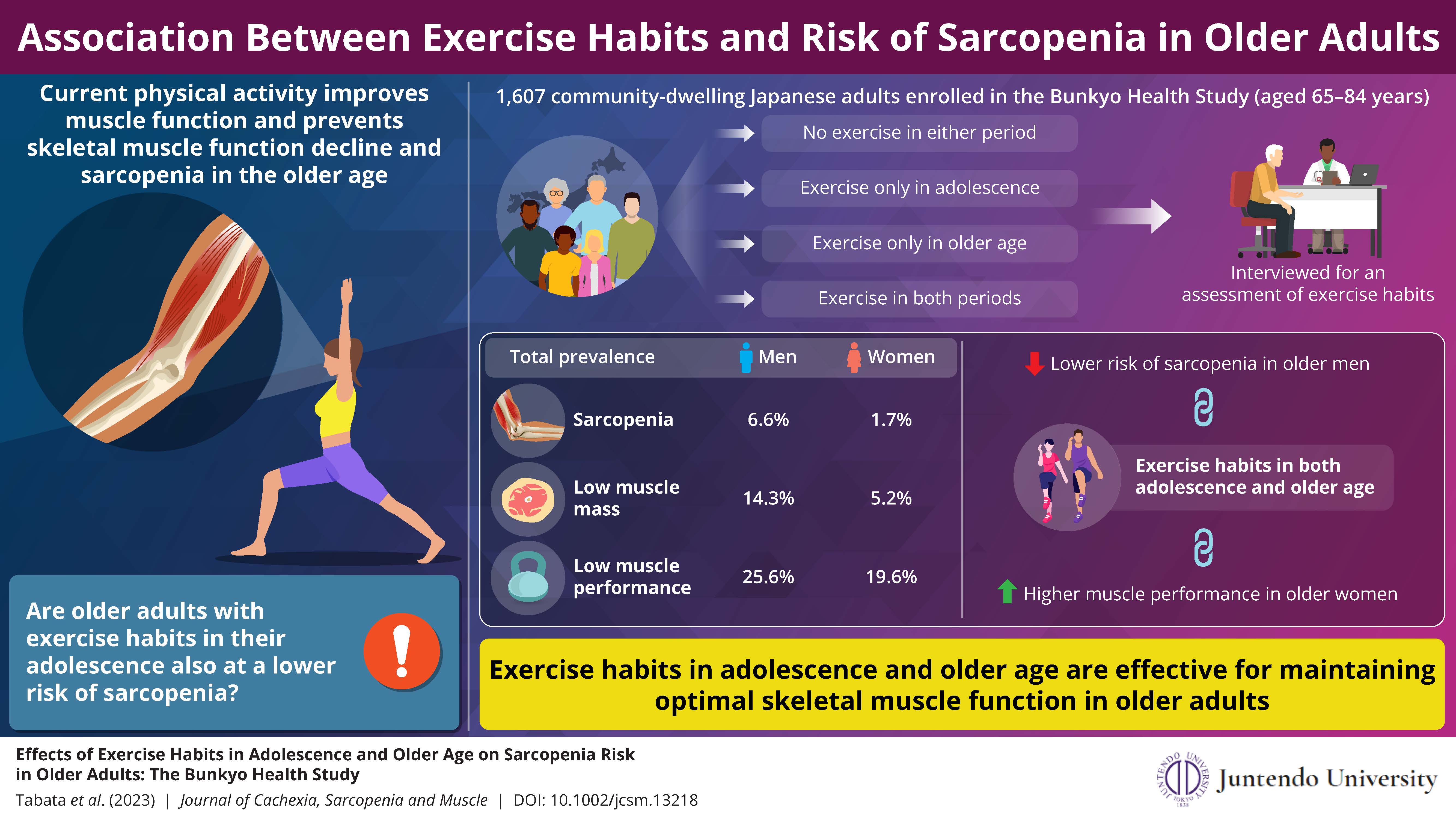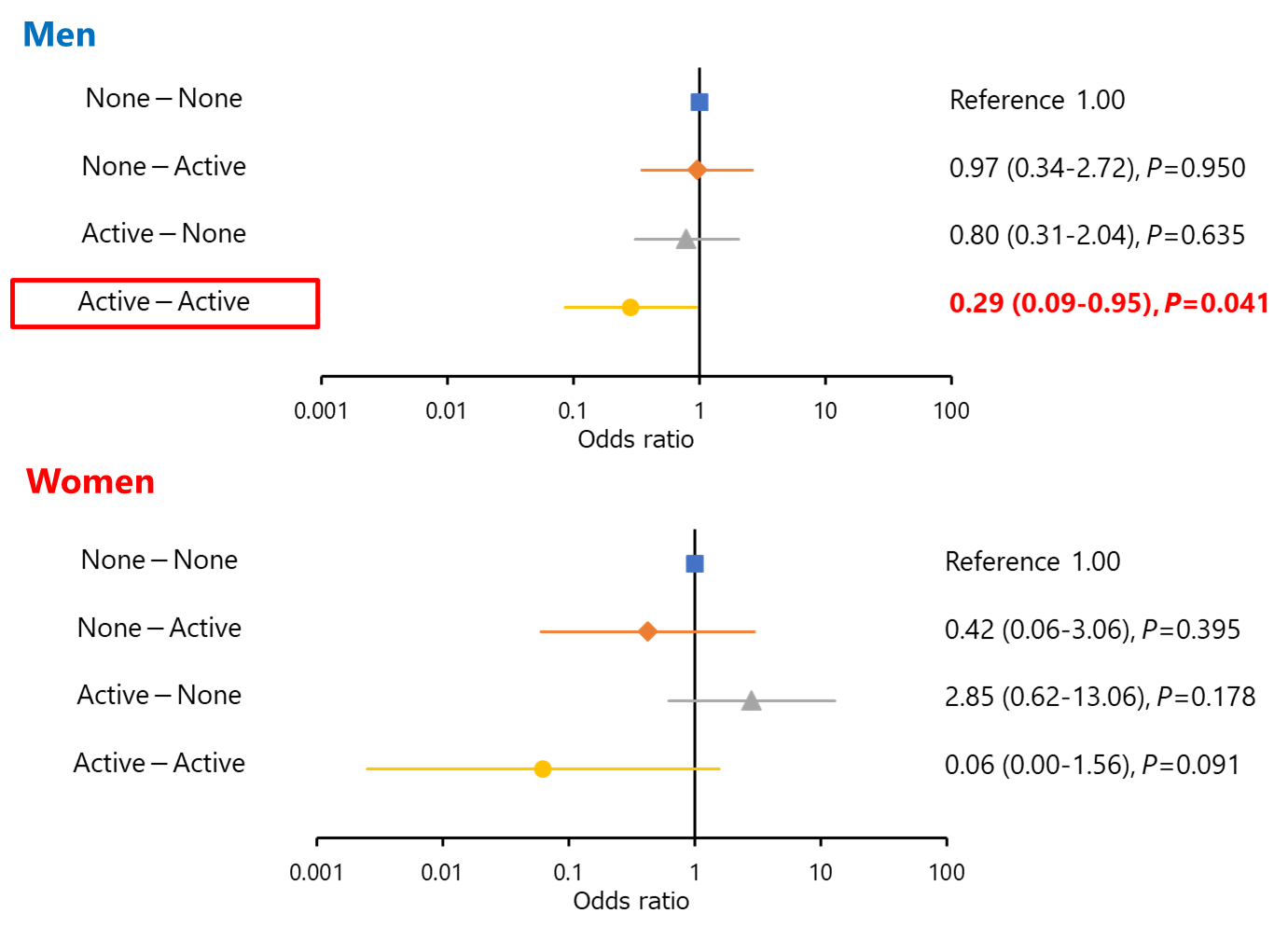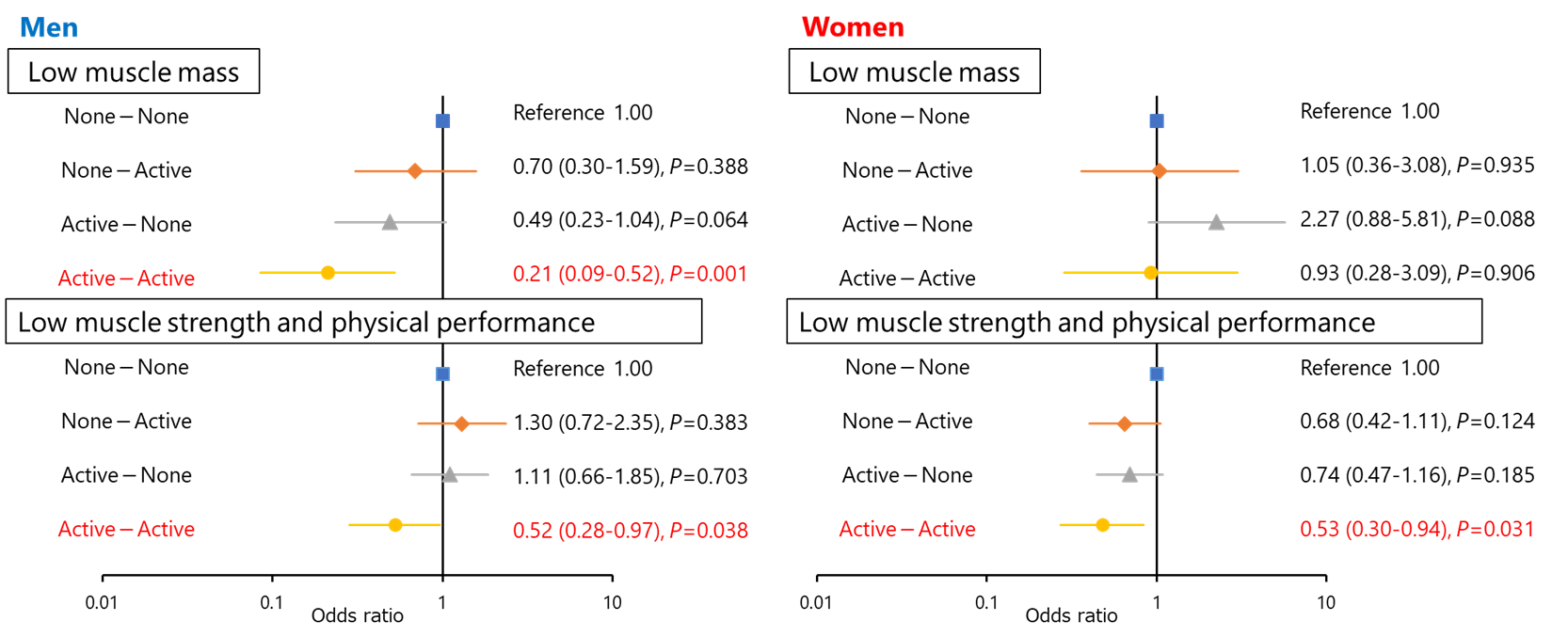Apr. 24, Mon, 2023
Topics
>RESEARCH
Effect of Exercise Habits in Adolescence and Older Age on The Risk of Sarcopenia in Older Adults
With the world’s largest rapidly aging population and several older adults requiring long-term care, Japan is facing a major public health crisis. A key risk factor for these soaring numbers is sarcopenia, an age-associated loss of skeletal muscle mass and function. In this new study, researchers from Japan investigate whether exercise habits not only during older ages but also during adolescence can prevent sarcopenia at an older age.
Association between exercise habits and the prevalence of sarcopenia
Association between exercise habits and the prevalence of sarcopenia
 Researchers from Japan show that regular exercise during adolescence may positively impact skeletal muscle function during older ages, thus lowering the risk of ‘sarcopenia’ or age-related muscle weakening
Researchers from Japan show that regular exercise during adolescence may positively impact skeletal muscle function during older ages, thus lowering the risk of ‘sarcopenia’ or age-related muscle weakening
Image courtesy: Hiroki Tabata from Juntendo University
Image license type: Original content
In a new study published in the Journal of Cachexia, Sarcopenia and Muscle on April 13, 2023, a research team led by Associate Professor Yoshifumi Tamura from the Faculty of International Liberal Arts, Juntendo University, including Dr. Hiroki Tabata, Dr. Ryuzo Kawamori and Dr. Hirotaka Watada of the Sportology Center, and Department of Metabolism & Endocrinology, Juntendo University, Graduate School of Medicine investigated whether the habit of exercising and being physically active not only during older ages, but also during adolescence lowered the risk of sarcopenia at an older age. “Preventing sarcopenia is an important strategy for preventing disability and the need for long-term care in the older age. By establishing the association, we can move one step closer to reducing risk factors of sarcopenia in older Japanese adults,”says Prof. Tamura.
The team assessed the exercise habits of 1,607 community-dwelling Japanese adults with comprised 679 males and 928 females aged 65–84, as part of the “Bunkyo Health Study”. The participants underwent a complete health examination, including measurements of skeletal muscle index, handgrip strength, and gait speed. They were further divided into four groups based on their exercise habits in adolescence and older age: no exercise in either period, exercise only in adolescence, exercise only in older age, and exercise in both periods. Multivariate-adjusted logistic regression models were used to estimate the odds ratios (ORs) for the prevalence of sarcopenia in each group. Low muscle performance was defined as low muscle strength and/or low gait speed.
Of the total participants, 6.6% of the men and 1.7% of the women had sarcopenia. Low muscle mass was prevalent in 14.3% of the men and 5.2% of the women, while low muscle performance was recorded in 25.6% of the men and 19.6% of the women. In men, the ORs for sarcopenia, low muscle mass, and low muscle performance were significantly lower in the group that exercised during adolescence and older age. In contrast, in women, the OR for low muscle performance was significantly lower in those who exercised during their adolescence and older age.
The study indicated that older men who exercised in their adolescence and older age were at a lower risk of sarcopenia and had better muscle mass and muscle performance. In contrast, older women with exercise habits during these phases of their lives were at a lower risk of poor muscle performance.
“We would like to emphasize that exercising not only during old age but also during adolescence, i.e., junior and high school, may influence the maintenance of skeletal muscle function in old age,” explains Prof. Tamura.
It is concerning that in Japan, the rate of exercise implementation has been shown to be highest during junior high school and then rapidly decreases with age. So, how do we address this problem?
Prof. Tamura responds, “By creating the awareness that inculcating the habit of exercising during adolescence, people can prevent several problems in their older ages. In the long run, exercising during adolescence has the potential to improve the quality of life of the older adults by providing maintenance of their skeletal muscle function.”
Kudos to the research team for highlighting the benefits of exercising on the risk of sarcopenia. We are confident that these findings will push more young people in Japan toward a healthier lifestyle!
【Image1】Association of four exercise groups with the prevalence of sarcopenia

*Adjusted for age, BMI, years of education, smoking history, protein intake, presence of type 2 diabetes, cardiovascular disease, osteoporosis, and exercise habit index from young to middle age.
The odds ratio of sarcopenia was 0.29 times lower in the group of men with exercise habits in both middle and high school years and in old age (present) compared to the group without exercise habits in both periods.
Image courtesy: Hiroki Tabata from Juntendo University
Image license type: Original content
【Image2】Association of four exercise groups with the prevalence of diagnostic elements of sarcopenia

*Adjusted for age, BMI, years of education, smoking history, protein intake, presence of type 2 diabetes, presence of cardiovascular disease, presence of osteoporosis, and exercise habit index from youth to middle age.
Compared to the group with exercise habits in both middle and high school and in old age (present) who did not have exercise habits in both periods, the ORs for the possession of reduced muscle mass and reduced muscle strength and physical function were 0.21 times and 0.52 times lower for men and 0.53 times lower for women, respectively than for the group with exercise habits in both periods, and the odds ratio for the possession of reduced muscle strength and physical function was the ORs were low.
Image courtesy: Hiroki Tabata from Juntendo University
Image license type: Original content
Reference
| Authors | Hiroki Tabata1*, Hikaru Otsuka2, Huicong Shi2, Mari Sugimoto2, Hideyoshi Kaga3, Yuki Someya4, Hitoshi Naito3, Naoaki Ito3, Abulaiti Abudurezake1, Futaba Umemura2, Mai Kiya3, Tsubasa Tajima3, Saori Kakehi1, Yasuyo Yoshizawa5, Ryuzo Kawamori1,2,3, Hirotaka Watada1,3 & Yoshifumi Tamura |
| Title of original paper | Effects of exercise habits in adolescence and older age on sarcopenia risk in older adults: the Bunkyo Health Study |
| Journal | Journal of Cachexia, Sarcopenia and Muscle |
| DOI | 10.1002/jcsm.13218 |
| Affiliations | 1Sportology Center, Juntendo University Graduate School of Medicine, Tokyo, Japan 2Department of Sports Medicine & Sportology, Juntendo University Graduate School of Medicine, Tokyo, Japan 3Department of Metabolism & Endocrinology, Juntendo University Graduate School of Medicine, Tokyo, Japan 4Juntendo University Graduate School of Health and Sports Science, Chiba, Japan 5Center for Healthy Life Expectancy, Juntendo University Graduate School of Medicine, Tokyo, Japan 6Faculty of International Liberal Arts, Juntendo University, Tokyo, Japan |